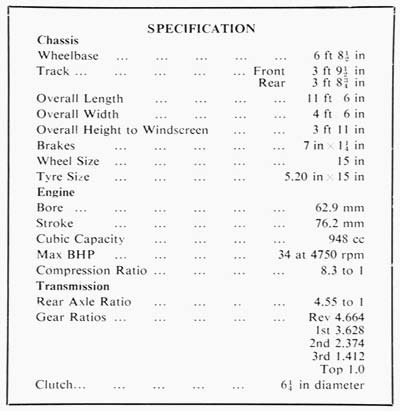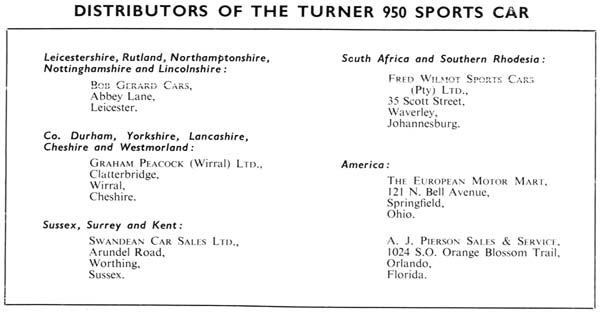| Turner Sports Cars | Articles |
| Turner Sports Cars | Articles |


| THIS fairly recent addition to the list of British cars, the Turner 950 can faithfully be described as a genuine hand-made sports car accommodating two people in perfect comfort, having an excellent performand and being both economical to run and inexpensive to buy.
Although Jack Turner has been making sports and racing cars for several years, it is only 18 months or so since the Turner Sports first appeared, with the BMC 803 cc ohv engine. During a period of steady development since, several modifications have been made, perhaps the most important of which has been a change over to the new 948 cc BMC engine currently fitted to the present Morris 1000 and Austin A35. The chassis frame is a rigid ladder-type construction made from 3 in diameter 16 gauge, 45 ton tensile strength, steel tubing. A prefabricated sheet steel framework takes the suspension, made up of Austin A 30/35 components with the exception of the coil springs which differ only in spring rate. The light weight of the car allows springing to be softer than normal. Outriggers from the main frame of the chassis provide support for the flooring. Rear end of the gearbox is rubber-mounted to the main cross member of the frame. The rear suspension makes use of a standard A 30/35 axle sprung by laminated 7/8 in square torsion bars attached to and located by trailing links. The prototype was originally equipped with 3/4 in square torsion bars, but the were inadequate. Lateral location is by a Panhard rod. The trailing links act as radius rods, but a true radius rod on the off-side of the chassis is mounted above the trailing link to prevent the axle twisting under acceleration and braking. Damping is provided by Girling telescopic shock absorbers mounted on a prefabricated extension aft of the chassis frame and anchored at the bottom to a bracket on the axle casing.  The wheels are 15 in diameter instead of the standard A30/35 13 in, so providing, with the 5.20X15 Michelin tyres, a considerably higher road speend per engine revolution. Brakes are Lockheed hydraulic. Drum diameter is 7 in all round, and the front brakes are of the two leading shoe type. Whereas rear brakes on the prototype were hydro-mechanically operated, they are now fully hydraulic shilst handbrake operation is by separate Bowden cables to each wheel instead of rods and levers. Steering is my modified Morris Minor rack and pinion, with steering column in two pieces connected by a universal joint. The now well-known BMC 948 cc engine needs little description. Fitted to the Turner, it is left completely as standard, except that it is fitted with two 1 1/4 in SU carburetters instead of a single unit. There is therefore, a special inlet manifold and a modified centre port on the exhaust manifold of Turner's own manufacture. The standard cooling fan is not fitted. The radiator is also Morris Minor pattern mounted low down on the front of the frame. Fuel is pumped from the rear mounted fuel tand by means of a "pulling" SU pump. The gearbox is exactly as fitted to the new BMC engine but with more suitable ratios than those on the original 803 cc unit. The only Turner modification in the "deparment" is to operate the clutch hydraulically by means of the Lockheed mechanism. Both brake and clutch pedals, of the suspended type, operate direct on to the two master cylinders. The Borg and Beck clutch itself remains unmodified.  The very pretty glassfibre body shell is made for Turner by Hills Fibreglass Developments Ltd of Wednesfield. It is supported by a 20 gauge sheet steel inner framework, the whole being firmly mounted to the chassis frame to give an extremely rigid construction. This framework is very useful for mounting engine accessories, fuel pump, fuse boxes, cut out and so on, as well as for carrying the brake and clutch master cylinders and pedals. The flooring also forms part of the steel frame. Seat frames are again of glassfibre construction with Dunlopillo cushions and trimmed in leathercloth. The hood is also in matching leathercloth over a tubular steel folding framework. The instrument panel is comprehensively equipped with large central speedometer, specially made by Smiths Motor Accessories Ltd., similar to that fitted to the original 1953 Austin A30 but reading up to 110 mph. On either aide of this are switches for windscreen wipers, choke, directin indicators of the flashing type, lights, starter and panel lights. To the left of the switches is an ammeter and to the right, the water temperature gauge. On the right-hand side of the steering column are the ignition switch, headlight dipper and horn button. The speedometer, of course, incorporates the ignition, oil pressure, and main beam warning lights. The filler cap to the 5 3/4 gallon tank on which is the spare wheel, is inside the locking rear boot. The direction flashers are incorporated in the twin rear lights and there is a centrally mounted stop light and number plate illumination light. Headlights are the normal Lucas 7 in type giving a very adequate beam, and the parking lights are fitted flush into the body beneath. The bonnet lik is hinged at the front and therefore cannot blow open at speed. The doors are made of sheet steel framework and have two very businesslike hinges. The elegany radiator grille is a solid aluminium casting of the eggbox type. The fixed windscreen, made from Triplex toughened glass, can be removed for racing. The only item listed as an optional extra to the car is a Delaney Gallay heater at £11, provision for which has of course been made. However, those who would have areally super performance, can fit stronger valve springs to permit higher engine revolutions before valve bounce sets in, and a compression ratio increased from the already fairly high 8.2 to 1 to about 9 to 1, and 1½ in SU carburetters. These modifications give appreciably greater acceleration and about another 10 mph in maximum speed under favourable conditions. As this car is normally made only to order, there is a very comprehensive choice of colour schemes. The body is available in either white, green, blue or red, and the upholstery in black, green, blue or red with hood and side curtains to match. As with all hand-built cars, the finish of the body is of a very high order. The glassfibre panelling having first,one coat of primer, after which it is carefully stopped and then a coat of cellulose primer added. Final finish consists of from 3-5 coats depending on the colour. In all cases, ICI paints are used. EXHILARATING PERFORMANCE On the road, the performance of the "standard" Turner 950 Sports is, to say the least, exhilarating. Fifty mph through the gears comes up in 13 secs, and in third gear a speedometer reading of 70 mph is easily obtained without valve bounce. Maximum speed is in the region of 90 mph. Although we only drove this fascinating car for a short time, the roads around the Turner factory at Pendeford Airport, Wolverhampton, were quite clear, and we were able to test the road-holding of the car almost to its limit, without indulging in racing-driver tactics. It is sufficient to say that the handleability of this car is remarkable in view of its simpicity. After the first fast corner, and accepting some roll which it holds, but continues to corner perfectly, it imparts afeeling of complete security and safety.  Driver visibility is exceptionally good and the seating arrangements most comfortable for both driver and passenger. As the weather was cold but fine during our short drive, we were unable to test the weatherproofing qualities but draught-proofing seemed as good as can reasonably be expected in this type of car. Sound-proofing of the engine was very good and the exhaust note was certainly not offensive by any standards. Braking at normal speeds was, in view of the rather small brake drums, very good indeed although heavy applications from maximum speed would probably cause a certain amount of "fade", as can only be expected. The new gearbox of the BMC unit can only be described as delightful, and a credit to its manufacturers. It is almost impossible to beat the synchromesh mechanism either when changing up or down the box. The position of the shortened and remote change lever could not be better. The rear-axle ratio chosen is the standard A35 of 4.55 to 1, which with the 15 in wheels gives 16½ mph per 1000 rpm. Jack Turner tells us that with the additional tuning to the engine 6000 rpm is obtainable without valve bounce, giving a maximum speed of just on 100 mph. This, from a hand-built car of under 1000 cc costing less than £800. Although we were unable to make an accurate fuel consumption test, we should imagine that if the Austin A35 gives 55 mpg at an average road speed of 30 mph, then the Turner must do at least 60 mpg under the same driving conditions. Official fuel consumption figure is give as 40 and 50 mpg under any conditions. It would seem, therefore, that the Turner Sports is just the car for the sporting enthusiast with petrol supply problems ! Theoretically this car should be able to win the Economy Run later in the year with ease since dry weight is a mere 10½ cwt and all-up, with fuel, water, oil and driver, cannot be more than 12½ cwt. Total price of the Turner 950 including Purchase Tax is £789 but, and here is the important fact, home constructors can buy various bits and pieces from Turner, the remainer of the part from their normal retailer, assemble the whole lot themselves and do the job for just over £550. Overseas enthusiasts can do even beter since the basic price of the complete car is only £525. The chassis complete with engine, gearbox, axles, suspension, wheels and typres costs £300 plus £76 10s Purchase Tax, or all that, less engine and gearbox for £185, plus £76 10s Purchase Tax. Alternatively, chassis frame with front suspension rack and pinion steering, rear suspension links and torsion bars and five sheels come out at £129 with no Purchase Tax to be paid. The body shell can be bought separately for £65 and the inner metal frame for £68. Additional parts which can be purchased individually from Turner's, which are not liable to tax, include the wiring loom at £3, the windscreen with brackets at £10 10s, the special propshaft at £5 5s, and the steering wheel and column at £5 15s.  To sum it up then. In the Turner 950 Sports, Great Britian now has available to all markets a true small capacity sports car, which, and this must be emphasised, is a pure road car not built for racing, although, no doubt a great deal of fun could be had with it in sprints, hill climbs and club handicap races. It cannot, of course, compete with the current 1100cc sports/racing cars, and is not intended to. However, one or two examples have already appeared on our race circuits, notably that driven by Rob Gerard in the Fibreglass Trophy Handicap Race at Brands Hatch last October, when it went very well.   |